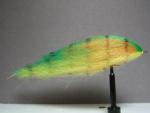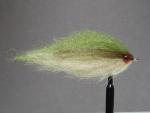-
Content Count
1,338 -
Joined
-
Last visited
Posts posted by deeky
-
-
My daughter turned 6 in March and she started tying this winter. She sits on my lap and I have lent a hand to help with a few of the trickier moves. But she does fairly well. The first has been set aside and labeled as her first. The rest are going with us to the Black Hills tomorrow.
Deeky
-
just wondering on how thick or thin i should tie said fliessorry for responding to this part of your post
i appreciate the response man i was just trying to get an idea thanks
Don't worry about it. You'll find that even though it's just typing, personalities can really come out around here.
For murky water, I would use the previous advice, but I would also save the natural looking patterns (olive/white) for clearer water. A red/yellow combination can be good in your conditions.
Deeky
-
Better yet, just buy naturally white (albino) peacock. I'm not sure about the normal material dealers, but check ebay. No chemicals, no burning, no bleaching. White from the start for you.
Deeky
-
The others have the materials covered. My only note is regarding finding balsa dowels. I searched long and hard for them and only ended up finding one online supplier that seemed quite high priced if I remember. On the other hand, you can find bala square-stock quite cheap at most big-box hobby stores and smallers ones that deal with rc airplanes. Some people will handcarve them, or you are going to have to set up a dremel lathe to turn your own bodies. Even if you use cork or the synthetic, you are going to need to turn them down smaller anyway.
Hope that helps.
Deeky
-
If you are talking yellow perch, they are big minnow-feeders and feed near the bottom. The few perch I've caught on the fly have been on Clousers. When they are on, they can be aggressive feeders.
Deeky
-
As far as the movement, I think you make a good point. If you have ever watched a dying fish, they deffinitely have their own movement. I would say use a fly that is lightly weighted at most. The dying fish I have seen jerk and then hang in the water column, so you want something close to neutral bouyancy. Also, use an open loop or even a snap for the connection to allow the fly to swing freely. Sharp tugs with a pause will often give it herky-jerky movement.
Deeky
-
It seems like discussion of predominant prey species always comes up when stocking is going on, particularly stocking of the larger predators. For example, the walleye fishermen don't want the muskies because they are afraid the muskies eat all of the smaller walleyes. The musky supporters argue that muskies far and away eat more rough species than they do the other game species. And so on and so on.
Now, we all know the Large Mouth like the Gills. Other than that, what has been your experience with baitfish patterns? Do you lean to imitating the other 'game fish' species, or do you go to the 'rough species' colorations (think carp, suckers, etc.)? And of course, there are those forage species (shiners, etc.) that I would probably throw in the middle - not exactly game species, but not exatcly 'rough species' either.
What do you tie? What have been your experiences on the water? I'm sure we all like to cover all of our possible bases, but where do you go first when throwing imitative flies?
Deeky
-
Hey Christopher, are those Zubaz in the background of your pictures? Very nice! Bringen em back!

-
Bass will definitely eat up the nymphs and small buggers, Clousers, etc. If you do want to stretch the size a little, use all synthetics in a streamer. It will shed water and allow you to cast a little larger fly on your 4-weight than you could if it were tied with a zonker or other water-absorbing material.
Deeky
-
A lot of EP's and bendbacks have material covering the point of the hook. You still won't be able to completely solve it, but switch to a fly with an open gape and exposed point. At least it will have a better chance of catching something of the fish on its way out.
Deeky
-
I also do a little bit of turning on my dremel. I got a needle at the big box hobby store that is intended for stitching leather. It is a little heavier gauge and has a three or four-sided point. The non-round point helps to hold the balsa from spinning. Just make sure you insert the needle absolutely as centered as possible.
deeky
-
Go over to Hatches Magazine and search for the Bergman Collection. I think most of them could be tied in a size 8 - I've read that a lot of the classics were tied much bigger back in the day than they are now. Size 8 really isn't terribly big.
Deeky
-
Minnesota seasons run about the same. Walleye, bass, pike, etc. close mid-winter and reopen about the same time as Michigan if I recall. Other than that, panfish is year-round.
Nice flies, really like the last one.
Deeky
-
It is certainly hand/home made. The markings on the base could possibly have already been on the metal if it was salvaged from something else. Remote, but possible. The jaws look to me as if they are needle-nose plier jaws which have been cut off and repurposed. I used to have a set of LOOONG needlenose pliers with jaws seemingly identical to those. Of course the maker might have just patterned the jaws after plier jaws.
It's a pretty neat vise.
Good call on the jaws. After that inspiration, the other end with the threads struck me as the adjustment knob from a pair of vicegrips.
Deeky
-
I have been tempted with the idea of tying with only natural materials. I've been close on a lot of flies other than some tinsel and the thread. If I were to carry through with it, it would simply be for the challenge of it - something new, which is the same reason I got into flyfishing in the first place. Haven't gone there yet, though.
Deeky
-
Try quantumfishing.com
-
So how fast can you turn out a rod? You've been posting about one a day. Are you really finishing at that rate? That's impressive, especially when you are assembling and turning your own grips. I know you quit smoking, so have you just replaced it with caffiene?
-
The video made it much clearer. You will either have a centrifical or magnetic system. The one for which he popped the side off was the centrifical with brake pads. However, it sounds like you have a magnetic with the dial of 1-10. So no side to pop off because there aren't pads inside to adjust. I can't say for sure, but logic would say that in a system with 6 pads, and he's only using three, you should be able to set your reel to a 5 or 6 and have about the same effect.
Deeky
-
No, udder balm is not bag balm. Do a search for 'udder balm' and you will get a number of brands and some of them have a 'store locator'. I'm assuming from the NYC in your name you are in New York City. Probably not a lot of farm supply stores around there. But udder balm is deffinitely different than bag balm.
Deeky
-
Without seeing the video, it's a little tough to say for sure, but I think you are on the right track. The dial you are referring to is the anti-backlash control. It keeps your spool from over-rotating on a cast. Turn it up, and you have less chance of backlash, but you also will lose distance on your casts as the spool is not as free to rotate.
If you go to Quantum.com, they have faq's that will address how to tune your antibacklash for your needs. You can tune it to the lures you are fishing. If you are new with casting a baitcaster, or like me - a little rusty, turn it up a couple of extra clicks to protect from backlash, then dial it back again as you get practiced up and are ready for a little more distance.
Hope that helps.
Deeky
-
Up until recently I haven't done much of anything with synthetic hair. Part of it was budget - most of it ain't cheap. I picked up a little Polar Fiber and liked it pretty well, but was looking for a little more bulk at times without packing on the material, as well as a little more length. So I hit up the mad scientist for his last Congo Hair T-Pack box. Yep, that is what I was looking for. Here's the first few:
6 inches, hot core
3 inches, tried to keep the bulk down, but ended up with more material in the fly than I wanted
3 inches, much happier with the amount of material
Pretty happy with the results. Now we just need to get rid of some ice before they can swim. Shouldn't be too much longer though. After looking at the link that was posted in another topic, I like the way they hung the rattle off the bend of the hook. I'll have to work that into a few, as well as playing with some articulated, mixed-materials flies.
Deeky
-
I do about the same as you. The only thing I'll add is to go to the dollar store, buy one of those pet flea collars and put a piece of it in each box. I've done that and never had a problem with bugs.
Deeky
-
That's a great job for your first fly. Like flytire said, some like them sparse. Personally, I would add a little more red and then only tie the red in ahead of the eyes. That way, the red flares just a little more and closes the gape a little more. While the clousers are fairly snagless anyway due to the inverted hook, having the hair in the gape will prevent grass from fouling and yet I haven't had any trouble with missing hookups.
Nice work.
Deeky
-
I use Aberdeen style hooks for my bendbacks. They are a light wire hook. Whatever you decide to use, keep in mind that with any forged hook, you really increase your chance of breaking the hook when you bend it. It has to do with the temper, molecular structure, yada yada yada. My suggestion would be go with the light wire hooks for true bendbacks or, like tidewaterfly said, use the wide-gap worm hooks that are already bent and flip point-up on their own.
Deeky





Bluegills on trout flies?
in Fly Fishing Gear & Techniques
Posted · Report reply
Will they work? I'll respond with a question - why waste a good fly on a snobby, high-brow, finicky trout?
Ok, add a great deal of sarcasm to that question, but seriously, cast away. It's great fun for beginners (better than trout in my serious opinion) all the way to life-long flyfishers.
Deeky